Notes on reviving the Bronx’s Westchester Avenue train station
Every year, Pratt Center awards Taconic Fellowships to Pratt Institute faculty, staff, and students working on collaborative community development projects throughout New York City. This year’s fellows were invited to share insights from their work with Notes On. This note was authored by Stephen Davies, Penny Lewis, and Yeswanth Loganathan who are working with residents of the South Bronx to co-create a public art installation at an abandoned train station.
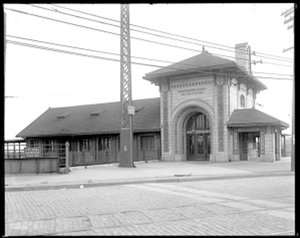
The Westchester Avenue station was built in 1907 by the well-known architect of the Woolworth Building, Cass Gilbert. However, it was abandoned in the 1930s and has remained vacant ever since. The station used to be a bustling neighborhood hub, and its current state of decline has been a cause of concern and interest for the community. As a first step in its restoration, a team of Taconic Fellows is developing a concept for a public art installation that is inspired and co-created with the community. The aim is to create art that visually resonates, but also creates awareness and inspires community involvement in the station’s rejuvenation process.
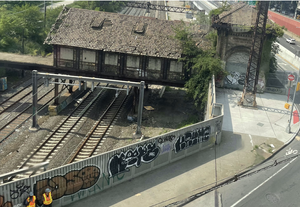
Professor Stephen Davies and graduate students Penny Lewis from the School of Architecture’s Urban Placemaking and Management Program and Yash Loganathan from the School of Design lead this community co-design process. The Pratt team is collaborating with Youth Ministries for Peace and Justice (YMPJ), a non-profit neighborhood advocacy organization that has been working to bring the station back to life for over a decade as part of the community’s plan for the Sheridan Expressway corridor.
Protective walls currently hide much of the station, virtually invisible in the vast intersection of Westchester Avenue and Sheridan Boulevard—within the socio-economically distressed area of the South Bronx known as the “Toxic Triangle,” created by the intersection of three major expressways. The long-term vision for the station and its surrounding district is a unique community destination with a synergistic cluster of cultural, food, recreational, and environmental uses that spur local entrepreneurship and empowerment. Specific long-term goals of the project include:
- Reconnect the community long divided by the Sheridan Expressway (now Sheridan Boulevard) and link the planned extensive new housing development immediately around the station district.
- Create community-driven neighborhood economic development and public spaces with commercial, cultural, educational, and recreational uses that serve community needs.
- Make the district a model eco-neighborhood, exploring all options for renewable energy and green building technologies while remediating brownfield sites and supporting the continued ecological restoration of the Bronx River.
A community outreach process completed separately by Professor Davies last spring identified potential uses for the station and surrounding areas, and an architectural and engineering study of the station’s condition is currently underway. During this process, public art repeatedly emerged as crucial to infusing community values and energy into the site, and the unique character of the site presents many specific opportunities for public art. Specific goals include celebrating the community, honoring the station’s history, activating and beautifying the site, and stimulating public interest and excitement about the station’s future.
Community Outreach
The Pratt team began its project last October with outreach at two interactive community events, a festival at an open street, and a community banquet in Concrete Plant Park adjacent to the station. At the open street festival, the team asked community members attending these events what themes and topics for the art would inspire them.
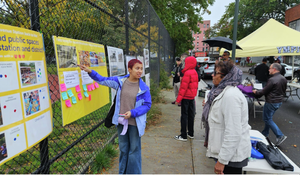
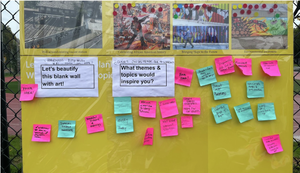
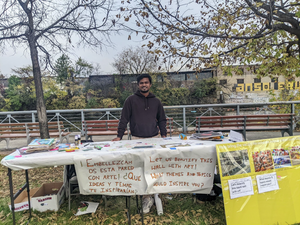

Following these events, YMPJ and the Pratt team hosted a community workshop attended by over 20 people on Saturday, November 18th, at River House on the Bronx River Greenway near the station site. During this workshop, the team introduced the project and history of the station, presented the results of outreach at the two community events, visited the site to analyze the space together, and brainstormed potential themes and topics the public art could address and how they could be visually represented.
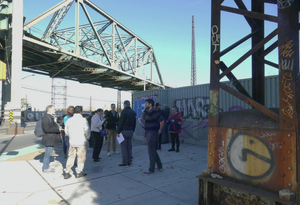
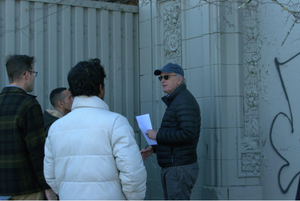
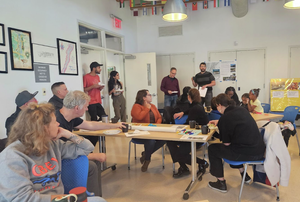
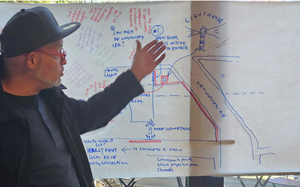
Themes and Topics for the Public Art
Through this community outreach, four common themes emerged that people would like to see public art potentially achieve:
- Tell the history of the station site and neighborhood;
- Reflect the diversity of people from the neighborhood;
- Create hope for youth and the future; and
- Build awareness in the community of the importance of nature and the environment.
Community workshop participants reinforced and elaborated on similar themes developed during the community events—history, communal space, and connection to natural and ecological elements (river, water, earth, plants, air). Participants used words like “flourishing,” “blooming,” “connections,” and “transitions” to describe potential overarching themes.
There was also a shared sense of the importance of creating a welcoming and accessible, well-lit space that draws community interest in the site. Specific art installation ideas included:
- Giving viewers a glimpse of the inside of the station as it currently is but also a taste of what the future of the site could be;
- Paying attention to how the installation is viewed, both at ground level and above from the elevated six subway train tracks at Whitlock and as it crosses the Bronx River;
- Including wayfinding and signage and other pedestrian improvements like benches as essential aspects of the project;
- Considering a wide variety of artistic mediums, including lighting installations, free-standing art projects, and murals that would change annually; and
- Conceiving the art installation as three separate but inter-connected sections: the entrance tower to the station at the corner of Westchester Avenue and Sheridan Boulevard, the protective wall facing Westchester Avenue, and the entrance to Concrete Plant Park.
Two more community workshops will be held in February and March to create visual imagery, refine artistic approaches to the installation, and finalize a concept. YMPJ will use the Pratt team’s design concept to fundraise for its implementation. The potential looks bright, as the process has built a lot of community enthusiasm for the art project.